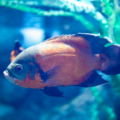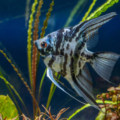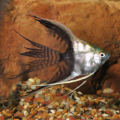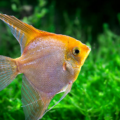Are you interested in popular aquarium fish for your community tank and have landed on the Silver Angelfish? Do you want to know if this ornamental fish species is worthy of its title or just another freshwater angelfish from the Amazons?

Introduction to Silver Angelfish
You’re in the right place for answers. I’m pleased to tell you that this species isn’t just one of the popular angelfish varieties, as it has some unique features that make it worth your time.
You’ll love this species whether you’re a beginner or an experienced aquarist. This comprehensive guide is your one-stop shop on all things Silver angelfish.
History and Natural Habitat
Don’t you just love a good origin story? That’s why I’m taking you back to the original natural habitat of angelfish before the selective breeding of different varieties. Silver angelfish are a tropical fish species from the South American Amazon Basin.
Based on its origins, this Amazon River fish requires a specific habitat for its survival. When building its tank, you must recreate a freshwater fish environment similar to that of the amazon to ensure it grows in its natural conditions.
There will be more on simulating the natural habitat of angelfish soon, but first, let’s look at their physical characteristics.
Physical Characteristics

The triangular shape and striking chromic silver body are the first physical characteristics of the Silver Angelfish appearance.
When you look closer, you’ll see that this fish’s silver coloration isn’t plain. Instead, it has black stripes that give it a subdued tone.
Another noticeable feature is the Silver angelfish’s fin structure — long, flowing, and elegant anal and dorsal fins, whether static or in motion. At full size, this species is 6” – 8” inches long.
How can you keep these features healthy?
Care Requirements for Silver Angelfish
Silver Angelfish care comprises several factors that prioritize your aquarium fish’s health. You must always maintain optimal water conditions with the right substrates and decor to protect their unique physical features.
The ideal water parameters for Silver Angelfish include 76 – 82℉ temperature, an almost neutral pH balance between 6.8 – 7, and 5 – 20 dGH hardiness.
I’ll dive deeper into tank maintenance soon, but first, I must tell you why your Silver Angelfish requires this much care. This species is sensitive to poor water quality, and its long fins make it prone to injuries.
So, the best thing you can do for your Silver Angelfish is to design an ideal tank. What does that look like?
Ideal Tank Setup for Silver Angelfish

You must consider your pet’s size and shape for the ideal Silver Angelfish tank setup.
Tank Size
You can have any aquarium design, but get a tall tank to accommodate its triangular body and long fins. It should be large enough to hold 20 gallons of water per Silver angelfish.
Tank Conditions
I’ve mentioned ideal tank conditions when discussing care requirements, but let me remind you. Silver angelfish are freshwater species that need cool water temperatures, not cold water.
Add a good filter, regulate the currents, keep it slow like a river, and then maintain moderate and shielded lighting. You don’t want direct reflections blinding your Silver angelfish, but it should be bright enough to help it wade through the waters.
Tank Design
You want your tank environment to be natural despite keeping these fish captive.
Use fine gravel, smooth pebbles, or sand for your substrate, and add live plants to the aquatic decor. But when choosing plants, note their characteristics and avoid species with sharp edges. Some options I recommend are Amazon Sword and Java Fern.
Note that Silver angelfish love foraging at the bottom of the tank. If you don’t feed your pets adequately, they may mistake the decor for food, so here are some tips on feeding and diet to avoid such mistakes.
Feeding and Diet

The Silver angelfish’s feeding habits are straightforward because this species is omnivorous. It’ll eat live food and plants without a second thought, but you must serve it as a balanced diet to avoid too much or too little of one food class.
Live foods like bloodworms, brine shrimp, and daphnia are nutritious fish food, but you can also add commercial foods like flakes, pellets, and freeze-dried food to your Silver angelfish diet. For plant-based diets, feed your pets blanched zucchini and spinach.
For more on feeding your aquatic pets check out The Ultimate Guide to Fish Food: Pros and Cons & Best Choices!
Feeding Frequency
Because every fish is prone to overfeeding, and this particular one requires clean, quality water all the time, you must feed it in small portions. Serve enough food that the Silver angelfish can finish in under 3 minutes twice daily to avoid leftovers messing up the tank water.
Contaminated tank water can lead to poor scale conditions, cause serious health challenges, and trigger other diseases.
Health and Common Diseases
Your Silver angelfish’s health is the basis for long life, shiny scales, elegant fins, and a vibrant tank. While this species is prone to common fish ailments like Dropsy, Parasites, and Fin Rot, it also has unique illnesses based on its physical characteristics and genetics.
Here are some tips on fish disease prevention, early detection, and effective treatment strategies to battle them.
Common Diseases and Their Causes
- Dropsy: Swollen body and raised scales caused by parasites or bacteria in the water. You’ll notice obesity and difficulty in swimming.
- Parasites: Parasites latching onto your Silver angelfish’s body. You may or may not see the parasites because they can be really tiny, but you’ll notice unusual swimming patterns or itching.
- Fin Rot: Damaged fin caused by bacterial infections. You’ll notice discoloration, fraying, or decay.
- Columnaris: Cotton growth on the scales caused by bacterial infection and internal organ failure. You’ll notice scale ulcers and cottony growth around the body from the gills to the mouth and eyes.
Effective Treatment Strategies
- Improve the water quality by ensuring optimal conditions and changing 20 – 30% of the tank water weekly or bi-weekly, depending on the size.
- Use antibacterial treatments for bacterial infections.
- Use antifungal treatments for fungal infections.
- Use anti-parasite treatments for parasitic infections.
Fish Disease Prevention
Nothing guarantees wellness like maintaining quality water parameters, a balanced fish diet, and a peaceful aquarium. Avoid triggering situations like competition for food, messy eating, and aggressive tank mates.
Also, periodic visits to the fish vet help ensure that your pets are always in good health. As the saying goes, “It’s better to be safe than sorry.”
And that’s everything you need to know about aquatic health care. Now, let’s discuss reproduction and creating more Silver angelfish.
Breeding Silver Angelfish
Knowing that this species is monogamous, how does breeding Silver angelfish work? It’s easier than you think, and I’ll show you the following:
Breeding Selection
Choose healthy adult male and female Silver angelfish as your breeders to give you the best batch of fry. You can identify the male by their robust and longer triangular bodies, broad head, tapered anal fin, and curvier dorsal fins.
Meanwhile, the females have more rounded triangular bodies, smaller heads with rounded anal fins, and are calmer.
This video has been very helpful in identifying the sex of angelfish, I highly recommend it:
Breeding Tank Setup
Keep the water parameters similar to the regular tank but make it warmer to prepare the female’s body for breeding. 80 – 84℉ is an ideal temperature.
Ensure your breeding tank has a flat surface for your female Silver angelfish to lay its eggs. The surface may be a smooth, wide leaf or a ceramic tile, but I recommend the former for soft landing.
Spawning
Are you ready to learn about Silver angelfish reproduction? There’s a mating ritual when the male chases the female around the tank to nudge her belly to lay eggs.
When the female Silver angelfish is ready to spawn, she finds a hiding spot after the male chases her around the tank and lays her eggs. The male species then fertilizes the eggs externally, which forms a membrane around the cluster.
Fry Care
Follow these fry-rearing tips for a stress-free growing period.
Within 4 – 6 days, the eggs will hatch and feed on their yolk sacs as they adapt to their new life. After 1 – 2 days of feeding on their yolk sacs, you must take over their diet. Feed the fry infusoria in the first 3 – 5 days, then move to crushed commercial fry food.
As they grow older, you can change their diet to smaller pellets or flakes, then later live food once they’ve become big enough to chew and digest it.
Reintegration
Within a week to two weeks of hatching, it’s time to add your grown fry to the regular tank. First, separate the larger fry from their counterparts to avoid predatory behaviors, but also don’t put the vulnerable fry in the same tank as matured Silver angelfish.
Ensure the fish is strong enough to live with others without looking like prey before you integrate it into a community tank. Now, you’re ready to expand your aquarium.
Behavior and Compatibility
If you want to add the Silver angelfish to a community tank, you’ve hit the jackpot because this species is calm. It’ll thrive in peaceful fish communities as long as it’s not breeding.
This freshwater fish is a class act in social behavior because it loves pairing and moves in groups. Don’t pair it with active and aggressive fish.
Aquarium Fish Compatibility for Silver Angelfish
Some compatible tank mates for your Silver angelfish are Rasboras, Tetras, and Corydoras Catfish.



Conclusion
Did you enjoy this Silver Angelfish care overview? Are you ready to add this freshwater variety to your community tank? If your answer to both questions is yes, welcome to the Silver Angelfish owner’s community. You won’t regret it.
Before I leave, I like to run through a checklist to ensure you’re prepared for ornamental fish care.
- Keep optimal water conditions.
- Select healthy breeders
- Feed a balanced diet.
- Treat health issues immediately.
- Pair Silver angelfish with calm species
Did you get all the fish-keeping tips right? You can always come back for more aquarium maintenance advice. For now, it’s goodbye.











1 thought on “A Comprehensive Guide to Silver Angelfish ”